Recipe
GOODNESS
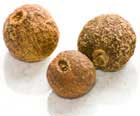 Allspice:
No, this isn't a mixture of everything in your spice rack, but rather a dried berry of the pimenta tree.
If that's a surprise to you, imagine how Columbus felt -- he thought it was pepper (thus the name pimenta,
which is Spanish for pepper). The berries look a little like plump peppercorns and the flavor is pungent,
but it is not pepper. The best allspice comes from Jamaica.
Allspice:
No, this isn't a mixture of everything in your spice rack, but rather a dried berry of the pimenta tree.
If that's a surprise to you, imagine how Columbus felt -- he thought it was pepper (thus the name pimenta,
which is Spanish for pepper). The berries look a little like plump peppercorns and the flavor is pungent,
but it is not pepper. The best allspice comes from Jamaica.For the freshest flavor, you should buy allspice in berry form and grind or crush it as needed. The taste is a pleasant mix of cloves, cinnamon and nutmeg. Used in jerks and for pickling, it goes great with meat and gives a nice kick to soups and stews. |
 Bay Leaf:
That green headband around Ceasar's head was bay, and it has a long and glorious
culinary history in Mediterranean countries.
Bay Leaf:
That green headband around Ceasar's head was bay, and it has a long and glorious
culinary history in Mediterranean countries.Bay can be bitter when fresh, so let it dry for a few days if you pluck it green from the tree. After drying, it keeps nicely in an airtight jar. It gives up its flavor slowly, which is why you add it to the beginning of slow-cooked soups and stews. It has a slightly musty aroma with shades of nutmeg that can overpower a dish, so only use half a leaf for each serving. Don't forget to pull them out before serving! |
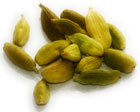 Cardamom:
This is a delicious spice with a citrus-like aroma that adds a wonderful flavor to Indian foods, among others. It is also know to be good for your liver, which in turn is good for entire body, since your liver helps you detoxify your blood. It is also good for your digestion, and is known to help with gas and the cramps that causes. The only caveat is that you might want to hold off on the cardamom if you are worried about gallstones. Otherwise, it can be a great addition to your recipes.
Cardamom:
This is a delicious spice with a citrus-like aroma that adds a wonderful flavor to Indian foods, among others. It is also know to be good for your liver, which in turn is good for entire body, since your liver helps you detoxify your blood. It is also good for your digestion, and is known to help with gas and the cramps that causes. The only caveat is that you might want to hold off on the cardamom if you are worried about gallstones. Otherwise, it can be a great addition to your recipes. |
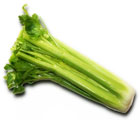 Celery:
Celery isn't just for Bloody Marys, although that's as close as many people get to this healthful veggie. Celery may have been used as a hangover cure in ancient Rome, but its real power lies in its ability to lower blood pressure and to keep your weight under control. If you have either of these problems (and they often travel together) you could do worse than grabbing a stalk of celery to chew on. Celery:
Celery isn't just for Bloody Marys, although that's as close as many people get to this healthful veggie. Celery may have been used as a hangover cure in ancient Rome, but its real power lies in its ability to lower blood pressure and to keep your weight under control. If you have either of these problems (and they often travel together) you could do worse than grabbing a stalk of celery to chew on. |
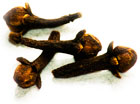 Cloves:
The dried buds of a tropical evergreen, cloves are a wonderful blast of fragrance and flavor.
They were the first known breath fresheners, but have a long, rich history in the spice trades.
These sweet but pungent buds can overwhelm a recipe, so beware!
Cloves:
The dried buds of a tropical evergreen, cloves are a wonderful blast of fragrance and flavor.
They were the first known breath fresheners, but have a long, rich history in the spice trades.
These sweet but pungent buds can overwhelm a recipe, so beware! |
 Coriander:
Coriander is used in both sweet and savory cooking, adding a mix of lemon and sage-like flavors to any dish.
In addition to its culinary flair, coriander has been considered to be an aphrodisiac by the ancients.
Whether or not you will find love, coriander seeds add a sweet, fruity note a recipe and are thought to be
good for both your mental powers and your digestion.
Coriander:
Coriander is used in both sweet and savory cooking, adding a mix of lemon and sage-like flavors to any dish.
In addition to its culinary flair, coriander has been considered to be an aphrodisiac by the ancients.
Whether or not you will find love, coriander seeds add a sweet, fruity note a recipe and are thought to be
good for both your mental powers and your digestion. |
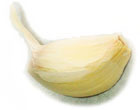 Garlic:
Garlic is in the same family as onions and leeks, and purportedly provided ancient Roman soldiers the courage to battle the barbarians.
Whether or not it gives you courage, it is known to lower blood pressure, which is great for your heart and helps prevent stroke.
In addition, it has a long history as a digestive aid, so don't be shy with this wonderful herb, no matter what it does to your breath!
Garlic:
Garlic is in the same family as onions and leeks, and purportedly provided ancient Roman soldiers the courage to battle the barbarians.
Whether or not it gives you courage, it is known to lower blood pressure, which is great for your heart and helps prevent stroke.
In addition, it has a long history as a digestive aid, so don't be shy with this wonderful herb, no matter what it does to your breath! |
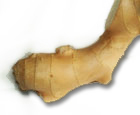 Ginger:
This spicy root is known as the universal remedy. Although it's well-known as a stomach soother, it also improves circulation, fights tumors, reduces inflammation and boosts the immune system. Oh, and it's good for pain and a fever. The only possible drawbacks are for people with gallstones or those on blood thinners.
Ginger:
This spicy root is known as the universal remedy. Although it's well-known as a stomach soother, it also improves circulation, fights tumors, reduces inflammation and boosts the immune system. Oh, and it's good for pain and a fever. The only possible drawbacks are for people with gallstones or those on blood thinners. |
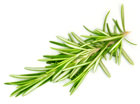 Rosemary:
This piney herb adds great flavor to many meats, but the surprise is how good it is for you. It has anti-inflammatory chemicals, making it useful in the treatment of liver and heart disease as well as asthma. It seems to have some potent anti-tumor properties and has been researched for its use against breast, colon and skin cancer. Although still being researched, it may be a useful tonic for the brain and has been used since ancient times as a memory enhancer. Although it is just fine in foods, you should avoid strong tinctures of rosemary if you are pregnant.
Rosemary:
This piney herb adds great flavor to many meats, but the surprise is how good it is for you. It has anti-inflammatory chemicals, making it useful in the treatment of liver and heart disease as well as asthma. It seems to have some potent anti-tumor properties and has been researched for its use against breast, colon and skin cancer. Although still being researched, it may be a useful tonic for the brain and has been used since ancient times as a memory enhancer. Although it is just fine in foods, you should avoid strong tinctures of rosemary if you are pregnant. |
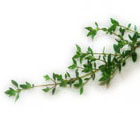 Thyme:
This aromatic herb has anti-inflammatory and anti-oxidant properties and contains thymol, a well-known antiseptic (you might be gargling with it). It's good for the digestion and is supposed to have some aphrodisiac qualities, although that just may be be due to the well-known connection between love and good food.
Thyme:
This aromatic herb has anti-inflammatory and anti-oxidant properties and contains thymol, a well-known antiseptic (you might be gargling with it). It's good for the digestion and is supposed to have some aphrodisiac qualities, although that just may be be due to the well-known connection between love and good food. |
ADVERTISEMENT
Help • Site Map • About Us • Contact Us • Privacy Policy • Press Center
Spice Plan™ Copyright © 2009 by Scott Charles Anderson. All rights reserved.